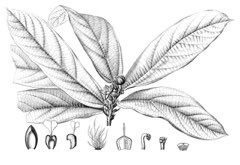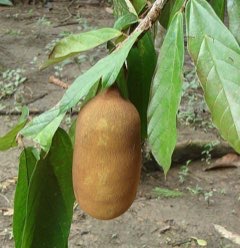 |
|
http://www.edibleplants.org |
 |
| Dick Culbert from Gibsons, B.C., Canada wikimedia.org |
Translate this page:
Summary
Theobroma grandiflorum, otherwise known as Cupuassu, grows up to 15 m high. It is evergreen with brown bark, elongated or pyramidal crown, and bole that can be up to 30 cm in diameter. It is common is rainforests in South America. The fruits are oblong, brown, and covered with a thick and hard exocarp. The fruit pulp can be eaten raw to made into juice, jams, and desserts. Seeds of this species are used as chocolate substitute. It is rich in oil and a great source of cocoa butter. It can also be used in cosmetics and pharmaceuticals. Medicinally, the plant is used in the treatment of abdominal pains, angina, high blood pressure, chapped skin and burns, and bruises. Plants are usually grown from seeds.
Physical Characteristics

 Theobroma grandiflorum is an evergreen Tree growing to 10 m (32ft) by 10 m (32ft) at a medium rate.
Theobroma grandiflorum is an evergreen Tree growing to 10 m (32ft) by 10 m (32ft) at a medium rate.
See above for USDA hardiness. It is hardy to UK zone 10. The flowers are pollinated by Insects, Wind.
Suitable for: medium (loamy) and heavy (clay) soils and prefers well-drained soil. Suitable pH: mildly acid and neutral soils. It can grow in semi-shade (light woodland). It prefers moist soil.
UK Hardiness Map
US Hardiness Map
Synonyms
Bubroma grandiflora Willd. ex Spreng. Guazuma grandiflora (Spreng.) G.Don Theobroma macrantha Bernou
Plant Habitats
Edible Uses
Edible Parts: Fruit Oil Seed
Edible Uses: Chocolate Drink Drink Oil
The fruit contains a number of large seeds surrounded by a very aromatic, succulent pulp with a slightly acidic flavour[335 , 416 ]. This pulp can be eaten raw and is said to be delicious[317 , 335 ]. Creamy, with an exotic flavour[318 ]. Sweetish and agreeably scented[420 ]. It is also used to make fresh juice, ice cream, jam and tarts[317 , 318 ]. The brown fruit is 12 - 25cm long and 10 - 12cm in diameter, with the pulp occupying about a third of the space within[335 ]. Seed - used as a substitute for chocolate[420 ]. The seeds have a high amount of fat and give a good cocoa butter[317 ]. The seeds of species in this genus are generally a rich source of oil (around 50%), starch (around 15%) and protein (around 15%)[636 ]. They also contain a volatile oil and the stimulating alkaloids caffeine and theobromine[636 ].
References More on Edible Uses
Medicinal Uses
Plants For A Future can not take any responsibility for any adverse effects from the use of plants. Always seek advice from a professional before using a plant medicinally.
Antibacterial Cardiac Emollient Hypotensive Skin Stimulant Tonic
The plant (part not specified, but it is almost certainly the fruit or the seed[K ]) is nutritive, stimulant and tonic[318 ]. The seeds are used in the treatment of abdominal pains[318 ]. The juiced fruit is drunk to facilitate difficult births[318 ]. Although no specific reports of medicinal use have been seen for this plant, the seed is a source of cacao powder and butter. These products have the following medicinal uses:- Cacao powder and butter, which are obtained from the seed, are nutritive[238 ]. The butter is also applied externally as an emollient[238 ]. Cacao powder is taken internally in the treatment of angina and high blood pressure[238 ]. Cacao butter is an excellent emollient, being applied to the skin to soothe and soften it[238 ]. It is used traditionally to treat chapped skin and burns, and is also rubbed into bruises[238 ]. Research has shown that it can help to counter the bacteria responsible for boils and septicaemia[254 ].
References More on Medicinal Uses
The Bookshop: Edible Plant Books
Our Latest books on Perennial Plants For Food Forests and Permaculture Gardens in paperback or digital formats.

Edible Tropical Plants
Food Forest Plants for Hotter Conditions: 250+ Plants For Tropical Food Forests & Permaculture Gardens.
More

Edible Temperate Plants
Plants for Your Food Forest: 500 Plants for Temperate Food Forests & Permaculture Gardens.
More

More Books
PFAF have eight books available in paperback and digital formats. Browse the shop for more information.
Shop Now
Other Uses
Cosmetic Furniture Oil Wood
Other Uses An oil, known as cacao butter, which is solid at room temperature, is obtained from the seed. In addition to being used locally as a food and medicine, cacao butter is important in the cosmetics and pharmaceutical industries[636 ]. The wood is of medium texture, straight-grained, moderately heavy and with moderate natural durability[420 ]. It is very little used, but is suitable for cabinet making and internal cladding of buildings[420 ].
Special Uses
Carbon Farming Scented Plants
References More on Other Uses
Cultivation details
Management: Standard Regional Crop
A plant of the hot, moist, lowland tropics[636 ]. It grows best in areas where annual daytime temperatures are within the range 20 - 30°c, tolerating 16 - 40°c[636 ]. It requires a mean annual rainfall within the range 2,000 - 8,000mm, evenly distributed throughout the year[636 ]. Requires a position where shade is provided by taller trees[420 ]. Prefers a relatively rich, circumneutral soil[636 ]. Prefers a pH in the range 5 - 6.5, tolerating 4.5 - 8.5[418 ]. The plant is not drought tolerant, being unable to withstand even short dry seasons without the protection of dense shade and local humidity[636 ]. Freshly planted young trees usually grow away moderately well[420 ]. A seedless variety of this species exists[416 ].
Carbon Farming
-
Management: Standard
Plants grow to their standard height. Harvest fruit, seeds, or other products. Non-Destructive management systems.
-
Regional Crop
These crops have been domesticated and cultivated regionally but have not been adopted elsewhere and are typically not traded globally, Examples in this broad category include perennial cottons and many nuts and staple fruits.
References Carbon Farming Information and Carbon Sequestration Information
Temperature Converter
Type a value in the Celsius field to convert the value to Fahrenheit:
Fahrenheit:
The PFAF Bookshop
Plants For A Future have a number of books available in paperback and digital form. Book titles include Edible Plants, Edible Perennials, Edible Trees,Edible Shrubs, Woodland Gardening, and Temperate Food Forest Plants. Our new book is Food Forest Plants For Hotter Conditions (Tropical and Sub-Tropical).
Shop Now
Plant Propagation
Seed - it has a very short viability, requiring high humidity and optimum temperatures to remain viable. There is no dormancy, the seed often germinating whilst still inside the pod[636 ]. Sow the seed as soon as it is ripe, in a semi-shaded position in individual containers[420 ]. Cover with about 15mm of soil. Germination rates of fresh seed is usually high, with sprouting taking place in 20 - 40 days[420 ]. Young plants are usually ready for planting out 5 - 6 months later[420 ].
Other Names
If available other names are mentioned here
Cacao blanco, Cocohuasu, Copoasu, Copoazu, Cupu-Assu, Cupuassu, Pupu, copoasu, copoasú, cupuassú, cupuasu, cupuaçú.
Native Range
SOUTHERN AMERICA: Brazil (Acre (west), Amazonas, Pará (south))
Weed Potential
Right plant wrong place. We are currently updating this section.
Please note that a plant may be invasive in one area but may not in your area so it's worth checking.
Conservation Status
IUCN Red List of Threatened Plants Status : This taxon has not yet been assessed

Growth: S = slow M = medium F = fast. Soil: L = light (sandy) M = medium H = heavy (clay). pH: A = acid N = neutral B = basic (alkaline). Shade: F = full shade S = semi-shade N = no shade. Moisture: D = dry M = Moist We = wet Wa = water.
Now available:
Food Forest Plants for Mediterranean Conditions
350+ Perennial Plants For Mediterranean and Drier Food Forests and Permaculture Gardens.
[Paperback and eBook]
This is the third in Plants For A Future's series of plant guides for food forests tailored to
specific climate zones. Following volumes on temperate and tropical ecosystems, this book focuses
on species suited to Mediterranean conditions—regions with hot, dry summers and cool, wet winters,
often facing the added challenge of climate change.
Read More
Expert comment
Author
(Willd. ex Spreng.) K.Schum.
Botanical References
Links / References
For a list of references used on this page please go here
A special thanks to Ken Fern for some of the information used on this page.
Readers comment
| Add a comment |
|
If you have important information about this plant that may help other users please add a comment or link below. Only comments or links that are felt to be directly relevant to a plant will be included. If you think a comment/link or information contained on this page is inaccurate or misleading we would welcome your feedback at [email protected]. If you have questions about a plant please use the Forum on this website as we do not have the resources to answer questions ourselves.
* Please note: the comments by website users are not necessarily those held by PFAF and may give misleading or inaccurate information.
To leave a comment please Register or login here All comments need to be approved so will not appear immediately.
|
Subject : Theobroma grandiflorum
|
|
|
|